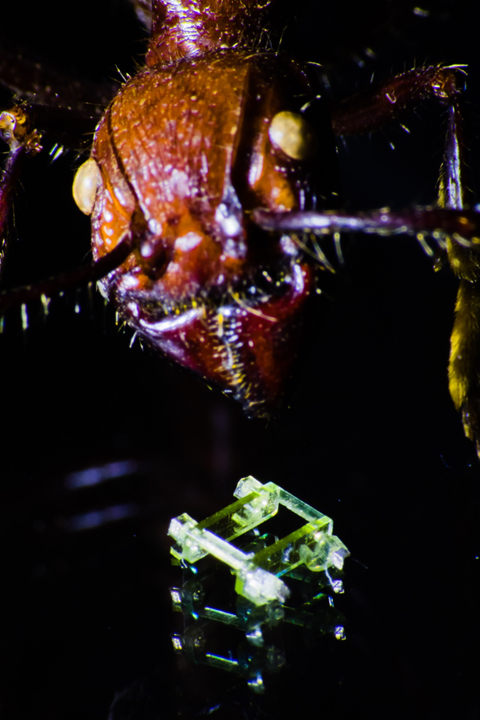Four-legged walking robot smaller than an ant head
As far as we know, the smallest walking robot in the world

A few years ago, Spectrum IEEE already wrote about the smallest of the four-legged robots that existed then - just 20 mm in size, with a height of legs of 5.6 mm and a weight of 1.5 grams. Its developer, Ryan St. Pierre from the laboratory of Sarah Bergbraeter at the University of Maryland, also showed us a photograph of an even smaller robot weighing only 100 mg. When we saw all this at the ICRA 2016 conference, we asked Ryan if he was going to go any further down the road:
"It is always interesting to solve the problem of making robots of the smallest possible size," he told us. - While I am working on creating a robot in the same pattern 2.5 mm long, which is an order of magnitude smaller than we presented on the ICRA. Smaller-sized robots are easier to get into places where large ones do not crawl through, and diversity in size increases their usefulness. ”
But it turned out that one order is not enough, and instead, Saint-Pierre developed a four-legged robot 10 times less than planned: it weighs only a milligram, and less than an ant head.
')
Ryan sent us videos with a working robot, although it’s hard to imagine how small it is. Imagine an ant for scale - it is not very large in its entirety, just a couple of centimeters long, and the size of a microrobot is 2.5 mm × 1.6 mm × 0.7 mm. His scheme is reminiscent of robots with rotating limbs, such as RHex , the mass of which is a million times larger than that of this micro-legged.
Like its predecessors, this robot is too small to use traditional electronics or motors. His legs are controlled by external magnetic fields that affect tiny cubic magnets embedded in his legs. Rotating magnetic fields force the magnets to rotate, which give the legs a rotational speed of up to 150 Hz. Having different magnets in the legs, you can achieve different types of gait. The robot's maximum speed is an impressive 37.3 mm / s, or 14.9 body lengths per second, and, surprisingly, the robot turned out to be quite resilient, having survived a million “no visible signs of wear or efficiency”.
To find out more, including real-life examples of using such robots, we spoke via email with Ryan Saint-Pierre.
IEEE Spectrum : Can you compare your robots with other walking robots of small scale?
Ryan Saint-Pierre : This paper presents one of the smallest and fastest microrobots that use legs for movement. There are microrobots and smaller ones, but they usually do not use legs for movement. This work helps to improve understanding of movement dynamics on milligram scales, both in robotics and in biology.

A milligram- sized robot next to a dried tropical ant's head paraponera clavata
The paper states that the orientation of the magnets in the legs leads to the hopping manner of movement of the robot. Why was such a walk chosen and what could be the potential benefits of other walk?
Gait can be set mechanically by choosing the orientation of the magnets relative to each other. Initially, I chose the jump version when all four magnets are directed in one direction in order to facilitate the manual assembly and location of the magnets. In subsequent versions, I used the trot movement when the arrangement of the magnets on the diagonal coincided. Gait is important when moving on smooth and rugged terrain, and, probably, when changing the surface, you need to change the gait, but at this stage of the project it is not possible.
What is the potential use of four-legged robots of this size?
The very first thing is to help understand the dynamics of movement with the help of legs on milligram scales, and to get more representative computational and physical models of running ants. Improving the understanding of the fundamental principles of movement at milligram scales will be useful for developing and managing autonomous robots of this scale.
Can you make the robot even smaller? What are the benefits and challenges?
Definitely possible. It all depends on the available technology for the production of magnetic material and the body of the robot. But if you reduce the size, leaving the scheme of transfer of effort to its feet the same, problems may arise. The friction forces will begin to dominate at the articulation points, which will require an increase in the torque power for turning the legs, and will reduce the efficiency of movement. Reducing the size compared to the current milligram will require a change in motor strategy. However, reducing the scale without changing the pattern of work and transfer of efforts will give us ideas about scaling ground movement with the help of legs, will reveal the fundamental restrictions on movement and give ideas about the evolutionary pressure in biological systems.
I admit, I am disappointed by the lack of plans to immediately send these small robots inside our body, so that they could run and fix everything, however, the short-term goals related to studying the movement of robots with legs on a small scale can be very small steps in this direction.
The work, “A milligram robot created on a 3D printer with legs, moving at a speed of 15 body lengths per second,” made by Ryan St. Pierre, Walker Gosrich and Sarah Bergbreiter from the University of Maryland (who now work at Carnegie Mellon University) was presented at conference 2018 Hilton Head Solid-State Sensors, Actuators and Microsystems Workshop, where she received an award for best work.
Source: https://habr.com/ru/post/441418/
All Articles